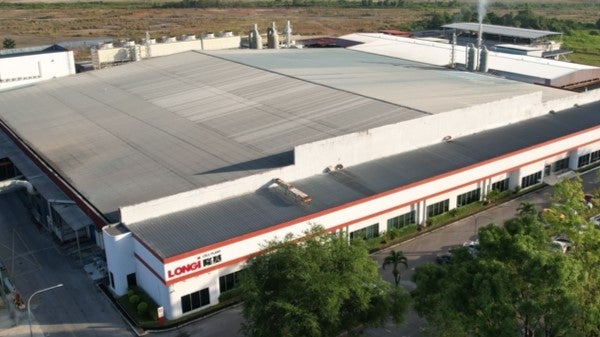
China-based Longi, a global leader in the manufacturing of solar panels and associated solar energy products, launched its Hybrid Passivated Back Contact (HPBC) solar cell last year.
The technology uses Interdigitated Back Contact (IBC) technology on P-type silicon chips to achieve a module efficiency of 23.3%. The electrodes and metal grid wires are stored in the back on the HPBC cells, creating a more visually appealing aesthetic, whilst also optimising light absorption.
Speaking to Power Technology, Jiang Dongyu vice-president of Longi’s Distributed Business Group, explains the significance of HPBC technology.
“Back contact technology is not new, however, the only company which can commercialize this product right now for a very reasonable cost is Longi,” Jiang says. “These products can generate power more efficiently in the same amount of space; some countries have a very limited amount of space. The same space can generate more solar power, which is extremely important. So, this technology can generate a higher commercial efficiency, but also has a better appearance because the grid line is in the back side, which improves the appearance of the cell.
“Because lots of solar will be installed in rooftops and in gardens, etcetera, people will still want it to look so nice. That’s the beauty of this technology. Last but not least: safety. This technology uses the one line zero welding technology which makes our solar panel more safe. In short: high efficiency, better appearance and also safety.”
Solar technology has become a major industry in China and has created over 300,000 manufacturing jobs across the country’s solar photovoltaic (PV) value chain since 2011, according to the International Energy Agency (IEA). The IEA notes that these jobs are reflective of the country’s $50bn investment in new PV supply capacity during this time, an investment it says is ten times that of Europe’s.

US Tariffs are shifting - will you react or anticipate?
Don’t let policy changes catch you off guard. Stay proactive with real-time data and expert analysis.
By GlobalDataFounded in 2000, Longi has been a leader of the Chinese solar industry during this period. The company has over 60.000 employees across over 30 operation sites globally and has led in global monocrystalline silicon wafer shipments for nine consecutive years.
“Since Longi started the company, we have always put technology innovation as the first principle to survive and to continue to grow,” explains Jiang. “That’s why we consistently invest in monocrystalline versus multicrystalline, because we think that commercial efficiency is the number one requirement in terms of solar manufacturing and solar panel development.
“We support cost reduction with a high efficiency product; in the last 10 years, we have helped the industry to reduce 90% of the cost, which has made solar power become really important and a major green power for the future 2050 carbon zero emission solution.”
According to the non-governmental organization Global Energy Monitor (GEM), China is set to meet its 2030 target of 1,200GW of wind and solar capacity five years ahead of schedule. It has said that, once the solar farms currently under construction are complete, China will add another 379GW in capacity to the 540GW of solar capacity it already has.
Outlining how new solar technologies, and specifically Longi’s HPBC cells, have helped to enable this transition, Jiang says: “The high commercial efficiency means you can generate more electricity power with limited space … This means we can use solar power, which is already the cheapest green energy, to further our journey to carbon zero emission. This gives China, and other countries, the confidence to announce they can reach carbon zero emission. Otherwise, if you have ambition, but you don’t have a solution, then it’s just words. You need a solution.
“In my view, our technology – including other partners or competitors – makes solar power absolutely the most important solution for all countries to reach carbon zero emission. This industry has become important and has also generated lots of employment, not only for China, but also for European countries. Many people make a living by installing solar panels and working in maintaining them.”
More broadly, Jiang believes China is showing real commitment to the green transition.
“Our whole country has a detailed plan,” he says. “Not only for distribution and the utility areas – for example, we have lots of a desert and the sea where they can produce lots of solar power and also wind – but also, if you look at the distribution generation area, we have also already installed a lot of solar panels.
“If you visit the rural areas in China you will see that solar is everywhere. In my view, China has a strong commitment, and action plan in place to ensure we reach our target. I think China has really made it the first priority.”



